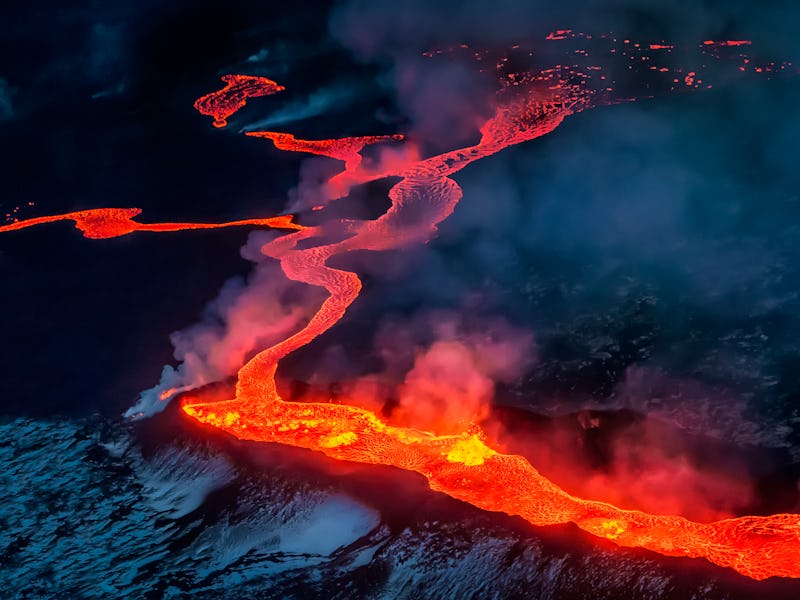Magma ocean discovery illuminates Earth’s extremely metal past
Researchers find physical signatures of Earth’s primordial magma ocean.

Around 4.5 billion years ago, Earth was — probably — one big ocean of magma. Geologists who study this primordial Earth use models, experimental simulations, and even samples from the Moon to figure out what the planet was likely like during the early days of the Solar System.
But finding physical evidence on Earth that confirms these models has been challenging. In a study published Friday in Science Advances, geologists announce they’ve found a direct signature of the primeval magma ocean in a famously old basalt deposit in Greenland.
The earliest Earth — This story actually begins with the Moon. The current prevailing theory is that long ago, a Mars-sized planet collided with the Earth, leaving us with a new satellite and an Earth melted from the impact.
“The idea that the Earth was largely molten — or even completely molten — at some point in time in its history is not a surprise,” Helen Williams, lead author on the study and a geochemist at Cambridge University, tells Inverse.
“The actual puzzle has been why isn’t there geological evidence for this.”
Why this matters — The reason it’s so hard to find a geological signature of something billions of years old on Earth is that it’s so tectonically active.
Surface rocks are constantly re-melted and re-mixed into the Earth’s interior, and there just aren’t many places where the surface rocks are, on these time scales, that old.
Greenland’s Isua supracrustal belt is home to some of the oldest exposure of rocks on Earth.
An exception to this rule is an area called the Isua supracrustal belt in Greenland. Here, basalt deposits are over 3.7 billion years old, and have escaped a lot of the deformation most other ancient rocks — say, in mountain ranges — have experienced. The site has been studied by geologists for decades, but this is the first time it’s been analyzed for the specific signature that would be left by a long-ago magma ocean.
“I’m really excited that we can find geological evidence for a process that so far we had only previously thought existed theoretically,” says Williams.
What’s new — The researchers found distinct geochemical signatures at Isua that give both the composition and timestamp information they needed to be able to trace them back to the primordial magma ocean.
The most abundant mineral on the Earth is called bridgmanite, which only forms at ultra-high pressures deep in the Earth’s mantle. The mineral has a preference for heavy versions of iron — isotopes like iron-57 — and other elements that give it a distinct signature. Even when the bridgmanite itself isn’t around, these signatures can remain. This is what the researchers found at Isua.
“... it’s the ultimate question about how did our planet form and why is it the way it is now.”
But the other key evidence was finding an isotope of the element tungsten, tungsten-182. This tells them that the bridgmanite signature must be very, very, old. Primordial magma ocean old.
That’s because this tungsten is a decay product of hafnium-182, an elemental isotope common in the early Earth (and only in the early Earth). Hafnium-182 would’ve decayed within the first 45 to 50 million years of the Solar System. Finding its by-products, a tungsten-182 signature, in a rock today, “tells us it’s inherited something incredibly primordial,” Williams says.
“This is a really interesting study that links together different types of geochemistry that haven’t been linked together before,” Steve Elardo, a planetary scientist at the University of Florida who was not involved in the study, tells Inverse.
“These kinds of studies help us understand what was going on very early in Earth’s history … it’s the ultimate question about how did our planet form and why is it the way it is now,” Elardo says.
Looking forward — Williams isn’t only excited about Earth’s magma ocean, she’s optimistic about the ways her entire field is changing.
“I think a lot of people, especially school kids, think about geologists as old white-bearded men hiking around in sandals with socks — and that’s not what the subject is anymore,” she says. “The subject is changing, it’s really multidisciplinary now, and it’s much more diverse than it used to be.”
“In some ways that’s the more important message,” she says. “Magma oceans are cool, but in some ways, diversity is far more important.”
Abstract: The differentiation of Earth ~4.5 billion years (Ga) ago is believed to have culminated in magma ocean crystallization, crystal-liquid separation, and the formation of mineralogically distinct mantle reservoirs. However, the magma ocean model remains difficult to validate because of the scarcity of geochemical tracers of lower mantle mineralogy. The Fe isotope compositions (δ57Fe) of ancient mafic rocks can be used to reconstruct the mineralogy of their mantle source regions. We present Fe isotope data for 3.7-Ga metabasalts from the Isua Supracrustal Belt (Greenland). The δ57Fe signatures of these samples extend to values elevated relative to modern equivalents and define strong correlations with fluid-immobile trace elements and tungsten isotope anomalies (μ182W). Phase equilibria models demonstrate that these features can be explained by melting of a magma ocean cumulate component in the upper mantle. Similar processes may operate today, as evidenced by the δ57Fe and μ182W heterogeneity of modern oceanic basalts.
This article was originally published on